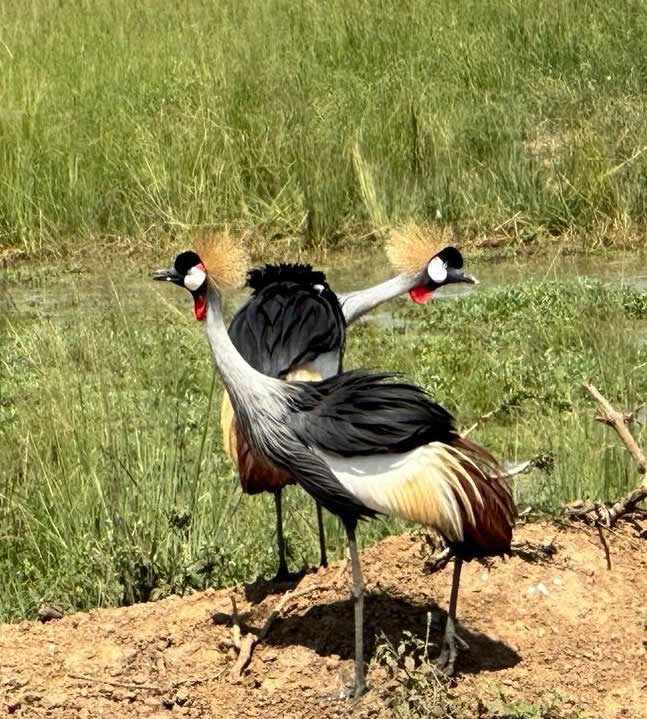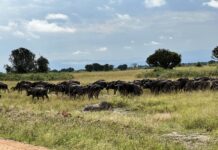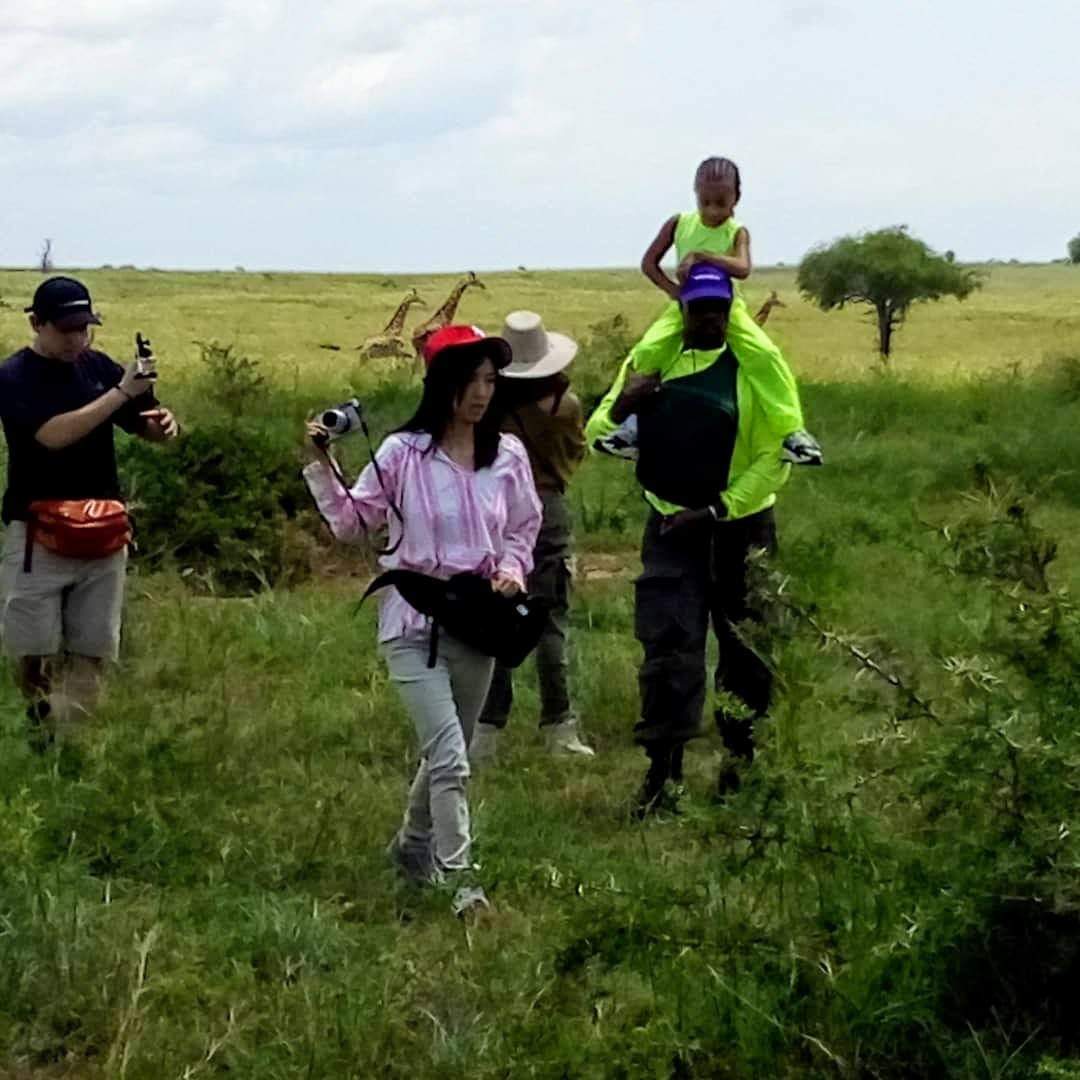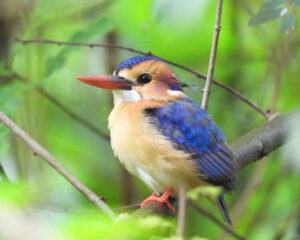
Explore the incredible birding paradise of Uganda, a country known as the “Pearl of Africa.”and renowned for its incredible biodiversity and rich bird life. The country boasts over 1,000 bird species, including numerous endemic and rare species. These birds are spread across the country, from open savannah to forests, swamps and wetlands allover the country. Note that birding can be done even enroute the different tourist destinations.
Key Birding Areas in Uganda:
Bwindi Impenetrable National Park: Famous for its population of mountain gorillas, Bwindi is also a prime birding destination. It is home to numerous Albertine Rift endemics, including the African Green Broadbill, Shelley’s Crimsonwing, African Emerald Cuckoo, and many others.
Queen Elizabeth National Park: Located in western Uganda, this park is renowned for its rich biodiversity. The diverse habitats, including savannah, wetlands, and forests, support a wide variety of bird species. Look out for the African Skimmer, Shoebill Stork, African Fish Eagle, and numerous waterfowl species.
Murchison Falls National Park: Situated in the northwestern part of Uganda, Murchison Falls National Park is the largest protected area in the country. The park offers excellent birding opportunities along the Nile River and in the savannah grasslands. Look for the rare and elusive Shoebill Stork, Goliath Heron, Abyssinian Ground Hornbill, and many raptors.
Kibale National Park: Known for its population of chimpanzees, Kibale National Park also boasts a remarkable avian diversity. The forested areas are home to species like the Green-breasted Pitta, African Pitta, Yellow-spotted Barbet, and Grey Parrot.
Semuliki National Park: Located in western Uganda, Semuliki National Park is part of the Congo Basin and offers a unique birding experience. The park is known for its lowland tropical rainforest and is home to species such as the Nkulengu Rail, Black Dwarf Hornbill, White-crested Hornbill, and many more.
Kidepo Valley National Park: Situated in northeastern Uganda, Kidepo Valley National Park is a remote and less-visited park, but it offers excellent birding opportunities. The open savannahs and rocky outcrops are home to various raptors, including the Pygmy Falcon, Ostrich, and Karamoja Apalis.
Mgahinga Gorilla National Park: This park in southwestern Uganda is known for its population of mountain gorillas and golden monkeys. It also provides habitat for bird species like the Rwenzori Turaco, Olive Pigeon, Rwenzori Batis, and Rwenzori Nightjar.
Lake Mburo National Park: Located in western Uganda, Lake Mburo National Park is a compact park with diverse habitats, including lakes, wetlands, and acacia woodlands. The park is home to species such as the African Finfoot, African Wattled Lapwing, African Fish Eagle, and numerous waterbirds.
These are just a few of the many birding areas in Uganda. Each location offers unique opportunities to spot a wide range of bird species, including endemic and rare birds.
Birding Highlights in Uganda:
Uganda’s birdlife is incredibly diverse. Some of the highlights include the shoebill stork, African green broadbill, African fish eagle, great blue turaco, grey crowned crane (Uganda’s national bird), African pitta, and several species of hornbills, weavers, sunbirds, and barbets.
The Shoebill (Balaeniceps rex): The iconic and rare Shoebill is one of Uganda’s most sought-after birds. It has a unique appearance with a massive shoe-shaped bill and can be found in wetland areas such as Mabamba Swamp and the Nile Delta.
African Green Broadbill (Pseudocalyptomena graueri): This stunning forest-dwelling bird is endemic to the Albertine Rift region of Uganda. Its vibrant green plumage, red throat, and peculiar calls make it a prized sighting.
African Fish Eagle (Haliaeetus vocifer): Known for its distinctive call and striking appearance, the African Fish Eagle is a common sight near water bodies, including lakes and rivers. It is recognized by its brown plumage, white head, and yellow beak.
Great Blue Turaco (Corythaeola cristata): This large and colorful bird is easily identifiable with its vibrant blue plumage, green wings, and red crest. It inhabits forests and can often be seen gliding between trees.
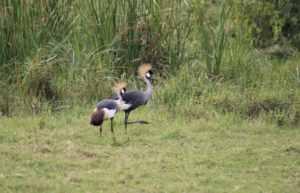 Grey Crowned Crane (Balearica regulorum): As the national bird of Uganda, the Grey Crowned Crane is a symbol of pride and conservation. It has a unique golden crown of feathers on its head and a graceful appearance.
Grey Crowned Crane (Balearica regulorum): As the national bird of Uganda, the Grey Crowned Crane is a symbol of pride and conservation. It has a unique golden crown of feathers on its head and a graceful appearance.
African Pitta (Pitta angolensis): The African Pitta is a small and secretive bird known for its stunning plumage. It displays a combination of bright colors, including blue, green, yellow, and red. It can be found in forested areas, particularly during the breeding season.
Secretary Bird (Sagittarius serpentarius): Although not exclusive to Uganda, the Secretary Bird is a large bird of prey that patrols the savannah. It has long legs, a hooked beak, and distinctive feathers on the back of its head resembling quills.
Bar-tailed Trogon (Apaloderma vittatum): This beautiful bird is part of the trogon family and exhibits vibrant green and red plumage. It can be found in the forests of Uganda, especially in the western regions.
Great Blue Turaco (Corythaeola cristata): The Great Blue Turaco is a large and colorful bird with a blue body, green wings, and a distinctive yellow beak. It frequents forests and can often be seen hopping between trees.
African Grey Parrot (Psittacus erithacus): Although native to various African countries, the African Grey Parrot is found in Uganda’s forests. It is a highly intelligent bird known for its ability to mimic human speech.
Best Time to Visit When Birding in Uganda:
The best time to visit Uganda for birding largely depends on your specific birding interests and priorities. However, there are a few general considerations regarding the country’s seasons and bird activity that can help you plan your trip:
Dry Season (December to February and June to August): The dry seasons are generally considered the best time for birding in Uganda. During these periods, bird activity is high, and the vegetation is less dense, making it easier to spot birds. Migratory bird species from Europe and northern Africa are present, adding to the diversity. The weather is generally pleasant, with fewer rainfall interruptions.
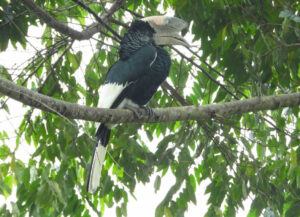 Wet Season (March to May and September to November): While the wet season experiences more rainfall, it does not necessarily mean birding is less enjoyable. In fact, some birders prefer the wet season as it offers unique opportunities. During this time, bird activity is still significant, and many resident species are breeding, displaying vibrant plumage, and engaging in courtship behaviors. The landscapes are lush and vibrant, providing picturesque settings for bird watching. However, it’s important to note that heavy rains might make some areas inaccessible, and roads may be more challenging to navigate.
Wet Season (March to May and September to November): While the wet season experiences more rainfall, it does not necessarily mean birding is less enjoyable. In fact, some birders prefer the wet season as it offers unique opportunities. During this time, bird activity is still significant, and many resident species are breeding, displaying vibrant plumage, and engaging in courtship behaviors. The landscapes are lush and vibrant, providing picturesque settings for bird watching. However, it’s important to note that heavy rains might make some areas inaccessible, and roads may be more challenging to navigate.
Migration Season: If you are particularly interested in migratory bird species, consider planning your visit during the migration seasons. The arrival and departure of these birds can vary, but generally, the best time to spot migratory species is from October to November and March to April. Migratory birds can be observed in various habitats, including wetlands, forests, and savannahs.
It’s important to note that Uganda’s climate varies across different regions and altitudes, which can influence bird activity. For example, higher altitude areas such as Bwindi Impenetrable National Park and Mgahinga Gorilla National Park have their own unique bird species and climate patterns.
Necessary Equipment to Carry on your birding trip
Binoculars: A good pair of binoculars is a must-have for birding. Look for binoculars with a magnification of 8x or 10x and a lens diameter of at least 40mm. Choose binoculars that are lightweight, comfortable to hold, and provide clear and bright images.
Field Guide: A field guide specific to the region or country you are visiting is invaluable for identifying bird species. Look for a comprehensive guide that includes detailed illustrations, species descriptions, and distribution maps. In the case of Uganda, we highly recommend the Bird of East Africa or Uganda.
Spotting Scope: While not essential, a spotting scope can be beneficial for observing distant or elusive birds. It provides higher magnification and better clarity than binoculars, allowing you to see more details. However, spotting scopes are larger and bulkier, so consider the weight and portability when deciding to carry one.
Camera with Telephoto Lens: If you enjoy bird photography, consider bringing a camera with a telephoto lens. This will allow you to capture detailed images of birds, even from a distance. Choose a lens with a focal length appropriate for bird photography, such as 300mm or longer.
Field Notebook and Pen: Keeping a field notebook is handy for recording your observations, including bird species, behavior, and habitat details. It is also useful for noting down specific field marks that can assist with identification later.
Clothing and Gear: Dress appropriately for the climate and conditions of your birding destination. Carry lightweight, moisture-wicking clothing in layers to adapt to changing temperatures. A wide-brimmed hat, sunscreen, insect repellent, and sturdy walking shoes or boots are also essential.
Water and Snacks: Stay hydrated during your birding trips by carrying an adequate supply of water. Pack some lightweight and energizing snacks to keep your energy levels up. This is simply because birding can be a strenuous exercise starting very early in the morning and ending very late in the evening with most of the day spent walking through the lush vegetation and forests.
Field Bag or Backpack: A comfortable and functional bag or backpack is essential for carrying your equipment, field guide, notebook, snacks, and other essentials. Look for a bag with multiple compartments for better organization.
Field Checklist: Consider printing or downloading a bird species checklist specific to your destination. It will help you keep track of the birds you’ve seen and assist with identification.
Mobile Apps: Birding apps on your smartphone can be helpful for quick species identification, bird calls, and additional information. Some popular apps include eBird, Merlin Bird ID, and iBird.
Note: The above equipment required may vary depending on the destination that you are visiting. It is a general guide that might not apply to all the places you may intend to visit.
